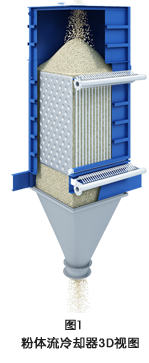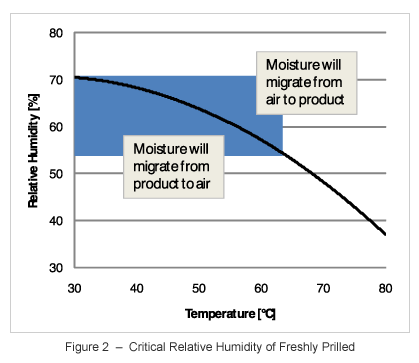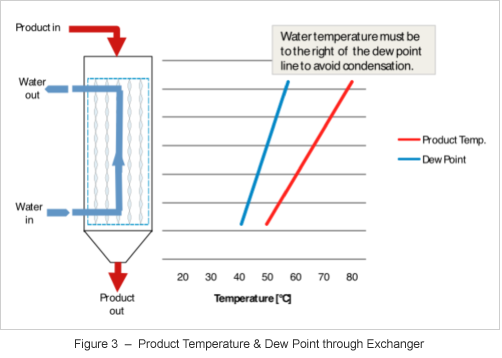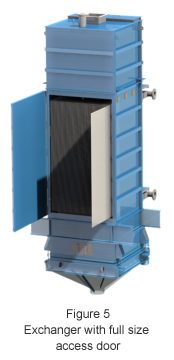文章和案例研究
粉体粒子冷却器-这项技术没有看上去那么简单

The concept of a bulk solid cooler for fertilizer products was introduced to the industry over 20 years ago. Since then Solex has installed more than 60 coolers of this type in fertilizer plants around the world cooling virtually every type of granular and prill fertilizer – urea, ammonium nitrate, NPK’s, MAP, DAP etc The basis of the bulk solids cooler technology is the gravity flow of product moving through a bank of welded heat exchanger plates, cooled with water. The advantages of the technology compared to the rotary drum or fluid bed coolers are virtually no dust emissions, low power consumption, compact design (a major consideration in retrofit projects) and a simpler overall system with little ancillary equipment, such as fans and scrubbers. These advantages quickly established the bulk solids type cooler as the preferred choice of cooler in many fertilizer plants.
The heart of the bulk solids cooler is the bank of exchanger plates. The product to be cooled flows slowly between the plates. Cooling water flows through the plates in counter flow and the product is cooled by conduction. Mass flow of the product is achieved by means of a Discharge Feeder mounted as an integral part of the exchanger below the plate bank. The Discharge Feeder also regulates the flow of product through the exchanger to keep it full at all times. A 3D view of a Bulk Solids Cooler is shown in Figure 1.
The basics of the bulk solids cooler technology are very simple, however there are a lot of details that need to be considered to ensure reliable operation.
Moisture – The Number One Enemy
Fertilizers contain a small amount of moisture, urea granules typically have a moisture content of somewhere between 0.1 to 0.2%。 MAP & DAP have a moisture content typically above 1%。 If uncontrolled, moisture leads to condensation on the cold surfaces of the exchanger plates, which will cause product to cake on the plates of the bulk solids cooler, reducing heat transfer performance, plugging the unit and quickly leading to the need for cleaning. However with a clear understanding of the science, the condensation mechanism is predictable and can be eliminated to achieve long on-stream time without the need for cleaning. The requirement is to keep the dew point of the air in the void space between the particles below the temperature of the plates. This will ensure that there is no condensation on the bulk solids cooler plates.
Fertilizers are hygroscopic, in other words, fertilizer will absorb moisture from the surrounding atmosphere when the vapour pressure of the air is greater than that of the product. Conversely, water transfers from the product to the surrounding air when the vapour pressure of the air is lower than that of the product. The tendency for moisture to migrate either from the product to the air, or from the air to the product is defined by the critical relative humidity of the product. The critical relative humidity curve for freshly prilled urea is illustrated in Figure 2.

The first observation that we can draw from this graph is that the critical relative humidity changes with temperature. So in a bulk solids cooler, the product cools as it passes through the exchanger, therefore the vapour pressure of the product decreases as the product moves through the exchanger and corresponding to this, the dew point also decreases. This gives us the scientific method of predicting the dew point at each point through the exchanger. This is shown in Graph 2 where product temperature and the dew point under equilibrium conditions are plotted as the product flows through the exchanger. From this graph we see that the dew point falls as the product cools down, we can take advantage of this by selecting water temperatures that follow the dew point line. This shows that at the top of the bulk solids cooler the water needs to be warmer to prevent condensation but progressively cooler water can be used as we move lower in the exchanger, with the coldest water at the bottom. This is a conventional counter-flow arrangement, which is always the most efficient thermal design for a heat exchanger. The description of this condensation mechanism is somewhat simplified based on equilibrium conditions, whereas in practice the transient conditions need to be modelled, which introduce a “time” term into the equations. Purge air can also be introduced which further helps to reduce the dew point of the air, allowing lower cooling water temperatures to be used which improves the thermal efficiency of the heat exchanger.

The science explains how the bulk solids cooler works from a process point of view. With a clear understanding of the science we can identify the following critical requirements of a bulk solids heat exchanger that will not cake and will maximize thermal efficiency:
Water Temperature
The water temperature profile needs to be carefully selected based on the hygroscopic characteristics of the fertilizer to ensure that the temperature of the plates will always be above the dew point of the air as the product flows through the exchanger.

Counter Flow Design
True counter flow design is required on the water side to parallel the dew point curve to maximize thermal efficiency. To take advantage of this, the fluid connections to the plate are at the top and bottom. This arrangement is shown in Figure 4.
Tempered Water Supply
a tempered water supply is required to ensure that the desired water temperature profile can be maintained under different operating conditions including start up when hot product fills the entire exchanger.
Purge Air
A purge air system can help to lower the dew point in the Product Cooler to allow lower water temperatures to be used and improve the thermal efficiency. When designing the purge air system, the air flowrate, dewpoint and locations where it is introduced and exhausted from the Cooler need to be evaluated.
Insulation
Evaluation of the dew point of the air in the Product Cooler may show that condensation will occur on the inside walls of the Cooler which may lead to caking on the inside walls of the exchanger and possibly corrosion. Condensation can be prevented by insulating the Cooler to keep the inside walls above the dew point.
Comprehensive Instrumentation
comprehensive instrumentation for the product, water loop and purge air is required so that the information is available to optimize the performance of the exchanger under varying operating conditions.
Experience with the Solex Bulk Solids Cooler in challenging conditions, cooling hot urea prills in a humid climate in India, has shown that with the correct combination of water temperatures and purge air, long term, reliable cooling can be achieved. Run-time between cleaning is in excess of 6 weeks which more than meets the typical operating time of the plant between shutdowns for more general plant cleaning. In urea granule service, run time is typically more than a year between shutdowns.
Inspection and Cleaning of the Bulk Solids Cooler

As discussed in the previous section, fertilizers are hygroscopic and if moisture is present have a tendency to cake. Even when the equipment is carefully designed, as described above, with the correct water temperature and air purge, upset conditions can occur and the result is caking on the plates. Fertilizers dissolve easily in water so the most effective way of cleaning is to wash with water. The following points should be considered when selecting a Bulk Solids Cooler.
Good access to the plate bank – in the Solex Cooler, this is provided by means of a full height, hinged access door. This is shown in Figure 5.
A convenient method of drying the cooler after washing, this includes the mass flow Discharge Hopper. This step is critical, if the cooler is not fully dry when put back into service, caking on the wet surfaces will happen immediately leading to a repeat of the cleaning step and further down-time. Drying is easily carried out using the purge air system to blow air through the exchanger. The drying time can be shortened by using the tempered water module to warm the plates.
With an efficient cleaning process the Product Cooler can be washed, dried and put back into service within a 4 – 8 hour turn-around.
Maintenance of the Bulk Solids Cooler
One of the principal benefits of the Bulk Solids Cooler compared to other methods of cooling bulk fertilizer is the simple design with few moving parts. Many of these exchangers have been in service for many years and have required minimal maintenance over that time period. However good design must consider and allow for the possibilities that can happen over the life of the equipment.
The main topic to discuss here concerns the stainless steel exchanger plates. The exchanger plates are inherently very robust, they are fully welded, thoroughly tested during the manufacturing process (which includes being hydraulically inflated at more than 40 bar pressure) and meet all pressure vessel code requirements. However they can be subject to corrosion. On the inside of the plates, corrosion can be caused by the cooling water, if chloride levels are higher than anticipated, leading to stress corrosion cracking or pitting. Likewise, corrosion can occur on the outside of the plates, more likely in fertilizer products containing chlorides such as NPK’s and if moisture is present. Instances of corrosion of the exchanger plates have been rare in fertilizer service and limited to conditions where chlorides are present.

To meet the requirement of replacing a plate, each plate is individually connected to external manifolds with threaded connections. All connections are outside the exchanger so that if there is a fluid leak it does not contaminate the product and furthermore is easily seen and corrected. With this arrangement, the plates can be removed and replaced through the full size access door. A further detail of this arrangement is the use of stainless steel flexible hoses, which allows for movement of the plates caused by thermal expansion. Figure 6 shows this arrangement.
In conclusion, the Bulk Solids Cooler used to cool fertilizer after granulation or prilling is a simple design concept that offers significant process and cost advantages over fluid bed or rotary drum coolers. Although simple in concept there are process and mechanical details that need to be considered. Fertilizers are complex from a chemical point of view; we need to understand the science of a fertilizer prill or granule as it cools, with this knowledge the equipment can be designed to operate without condensation and caking. Similarly, the mechanical aspects of the design have to be taken into account; the Bulk Solids Cooler will be expected to operate for 20 plus years in a fertilizer plant environment where equipment must be robust and easy to maintain. By getting the details right, these operating and maintenance requirements can be achieved.
询问专家
有问题?
需要更多信息?
我们随时准备提供帮助。